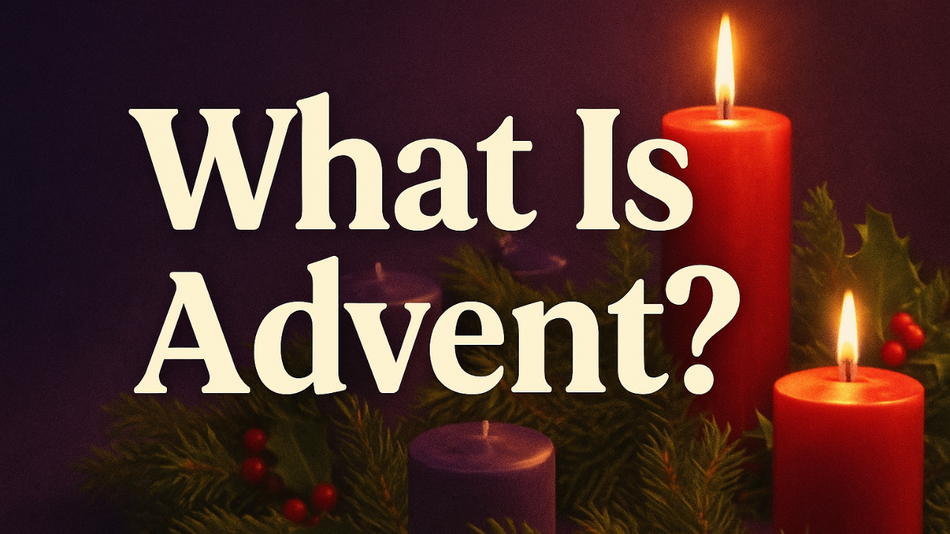My wife introduced me to Advent. It didn’t happen when we first got married. However, once we had kids, my wife wanted to bring Advent traditions into our home. We would buy the calendars with chocolate, which became more meaningful and fun as our kids grew into toddlers and kindergarten age.
Then I began serving at a church that celebrated Advent. We structured our services to follow the different weeks of Advent leading up to Christmas. Through the local church and our own exploration, we incorporated traditions and lessons from Advent into our lives.
While I didn’t grow up in a church that observed Advent, I have grown to love the season more and more. It helps us focus on Christ throughout the whole month when we’re so easily tempted to get busy and consumer-driven.
What Are the Origins of Advent?
Advent prepares the heart and faith community for the coming of Jesus Christ. The word “advent” comes from the Latin adventus, meaning “coming” or “arrival.” Christians observe Advent as a time to reflect on Christ’s first coming in Bethlehem, so it happens before Christmas. At the same time, believers look forward to Jesus’ promised second coming.
Advent traces back to the early Church. By the late 4th and 5th centuries, church leaders in Gaul and Spain started setting aside a time before Christmas for fasting, repentance, and preparation, similar to Lent before Easter. The Advent season was formalized by the 6th century when Roman Christians started to observe it connected with the coming of Jesus in future glory, as well. In the late 6th century, Pope Gregory I shaped Advent as a time of joy and anticipation instead of only sorrow and penance, distinguishing Advent from Lent.
Advent traditionally begins on the fourth Sunday before Christmas Day (December 25). This means it can start anywhere from late November to early December. It always ends on Christmas Eve, December 24. Each Sunday has its own theme, and they progress through the season—hope, peace, joy, and love. Usually, people and churches light candles in an Advent wreath. The third Sunday, known by many as Gaudete Sunday, really highlights joy as Christmas comes closer.
The Advent wreath originated in the 19th century when German Pastor Johann Hinrich Wichern used a wheel with candles to teach children what it meant to wait for Christmas. Over time, churches adopted this circular evergreen wreath with four weekly candles to symbolize eternal life and the increasing light of Christ as Christmas approached.
For many Christians today, Advent remains a powerful time to focus on Christ during the busy holiday season. It encourages us to slow down and intentionally reflect on the miracle of the Incarnation, the Immanuel, God with us. Additionally, we re-center our lives on being watchful and waiting for Christ’s return. This happens through Scripture readings, prayers, devotionals, and family traditions like calendars and wreaths.
What Are the Themes and Traditions of Advent?
The central themes of Advent include hope, peace, joy, and love. These themes express key aspects of Christ’s coming, both two thousand years ago and in his return: hope in his promises, peace through his reign, joy in his salvation, and love through his sacrifice. Each week during the four Advent weeks, churches and families meditate on a theme for their thoughts and worship.
One of the most famous traditions of Advent is the wreath. The circular wreath, made of evergreen branches, symbolizes eternal life and God’s love. The wreath holds four candles, three purple and one pink, arranged around the circle. Sometimes people place a fifth, white candle at the center for Christmas. Each candle represents one of the four weeks, and churches or families will light them to count down to Christmas.
Christians use the purple candles for hope, peace, and love. Purple is a traditional color for royalty and repentance. It reminds Jesus' disciples to prepare their hearts in humility, expecting the coming King. The pink candle, lit on the third Sunday, represents joy. The lighter color breaks up the more solemn mood and becomes more celebratory. The optional fifth, white candle is called the Christ candle and will be lit on Christmas Eve or Day, depending on the denominational tradition. The candles symbolize Jesus as the Light of the World (John 8:12).
Other Advent traditions include daily or weekly Scripture readings, Advent calendars with prizes inside each day, devotional booklets, and special church services. Some families try to engage in acts of charity or generosity, like volunteering at a local co-op or homeless shelter. Advent calls people away from worldly things to the spiritual, the most important, and other families will intentionally fast from distractions or donate to those in need. Church services will play or sing hymns and carols emphasizing Christmas, the weekly theme, or waiting on prophecy to be fulfilled.
How Do Different Christian Denominations Observe Advent?
Since Advent has been around since the 500s, and many Christian groups now exist, different denominations have developed their own ways to observe Advent, even though they share the common purpose of preparing for the coming of the King of Kings to the earth.
The Roman Catholic Church observes Advent with reverence and liturgy. Catholics attend special Masses that follow the Advent lectionary (the schedule of Scripture readings and messages). These Advent Masses focus on the Old Testament messianic prophecies, John the Baptist’s call to repentance, and the narratives from Luke and Matthew leading up to Jesus’ birth. Churches will use purple vestments or robes to symbolize a spirit of penitence and preparation. Others use blue to reflect the hope of Jesus. Gaudete Sunday, the third week of joy, incorporates rose-colored vestments as a lighter theme. Catholic families will have Advent wreaths in their homes, maybe light candles, and read devotionals along with using Advent calendars.
Anglican and Episcopal churches follow a similar liturgical calendar and observe Advent in ways like the Catholic tradition. Along with services with Scripture readings and hymns based on the four themes, they might host Advent Lessons and Carols, a special service combining the reading of the Christmas Bible story and music about the coming Messiah. Another liturgical denomination, the Lutherans incorporate the Advent wreath into worship services, often happening midweek to provide time and margin for quiet reflection. Their hymns—like “O Come, O Come, Emmanuel”—have become famous, longing for Christ’s presence.
Other Protestant/evangelical denominations (Methodists, Presbyterians, and Baptists) also celebrate Advent to some degree, although not as strictly or liturgically. Their practices vary widely across a spectrum, whether full-on Advent observance or simply using the weeks as a sermon series guide. Some churches incorporate Advent through a devotional or special music. Many evangelical churches will encourage or organize acts of service leading up to Christmas.
Eastern Orthodox Christians don’t celebrate Advent, coming from a non-Western tradition, separate from the Catholic background. However, they have a similar period called the Nativity Fast. The fast begins on November 15 and lasts 40 days like Lent before Easter. The Nativity Fast has prayer, fasting, and giving to the poor. Orthodox liturgies and hymns build toward a different day of Christ’s birth, January 7 (following the Julian calendar).
No matter the degree observed or the tradition, the Advent focus remains the same across all churches. Christ has come. Christ will return.
What Are Some Advent Scripture Readings and Prayers?
For the first week of Advent, hope, a traditional reading comes from Isaiah 9:2-7. “The people walking in darkness have seen a great light.” Romans 13:1 also fits the theme. “And do this, knowing the time, that now it is high time to wake out of sleep; for now our salvation is nearer than when we first believed.”

A prayer for the first week of Advent: “Lord, awaken our hearts to your coming. Help us live in the light of your truth and prepare the way for you.”
The second week and candle centers on peace. Isaiah 40:1-5 offers us the powerful words, “Comfort, comfort my people.” Also, Isaiah 9:6 calls the Messiah the Prince of Peace, and we rest in his rule and reign which brings peace with his Kingdom government.
A prayer for the second week of Advent: “God of peace, calm our anxious hearts. As we wait for your Son, make straight our paths and renew our trust in you.”
Joy comes with the third week. Living in the Messiah’s rule and reign, his joy is our strength. Isaiah 61:1-3 speaks of how Christ will bring good news to the poor and brokenhearted. The anointed one will give the oil of joy from mourning and beauty for ashes, reasons to celebrate. A great verse to read and explore would be Luke 1:46-55, Mary’s Magnificat, where she expresses deep joy in God’s redemptive plan for salvation.
A prayer for the third week of Advent: “God, be our joy. Fill us with the song of Mary. Help us rejoice in your mercy and salvation. Guide us to share your love with the world.”
The fourth week of Advent focuses on God’s love. Micah 5:2-5 prophesies the birth of a ruler from Bethlehem, God sending his Son out of love so people could live and not perish (John 3:16). Reading Luke 1:26-38 covers the angelic announcement to Mary regarding her being with child.
A prayer for the fourth week of Advent: “Heavenly Father, your love came to us through Jesus. May we receive him willingly with the same faith and obedience as Mary.”
When lighting the fifth candle for Christ, readings could include John 1:1-14 and Luke 2:1-20. Isaiah 7:14 says, “Therefore the Lord himself will give you a sign: Behold, the virgin shall conceive and bear a Son, and shall call his name Immanuel.” These proclaim the incarnation, God with us.
A prayer to celebrate Christmas: “Glory to you, O God, for the gift of Jesus. Let his light shine in our hearts, our homes, and our world. As we welcome the Savior born in Bethlehem, may we carry his peace into every day. Fill us with joy, deepen our faith, and help us to love as he loved. In the name of Christ our Lord, Amen.”
How Can We Embrace the Hope of Advent Today?
Advent isn’t just about counting down the days until Christmas but preparing hearts to receive the hop, peace, joy, and love that Christ brings. Advent helps show us how Christ is both with us as a present reality and someone to look forward to experiencing more fully in the future. God kept his promises two thousand years ago and will again. We can celebrate both what he’s done for us and what he’s yet to do through Advent.
In a world filled with anxiety, noise, and division, Advent teaches us to wait with purpose and trust God’s timing. We embrace the hope of Advent by remembering God’s faithfulness. With this hope, we intentionally take time to focus on the Messiah, letting his Word renew our mission and purpose. This hope isn’t emotional optimism but a secure confidence the same Christ who came will come again.
If you’ve never practiced Advent before, start simply. Light a candle each Sunday for the four weeks leading up to Christmas and reflect on the themes. Great, free resources exist online to go through daily or weekly devotionals with Scripture passages and prayers. Companies make various Advent calendars where you open one little door a day and get a prize, like chocolate or even a LEGO character. The calendars can be a great way to introduce Advent to the family.
You can—and should—serve others. Donate to people in need, volunteer at a local charity, or simply write encouraging notes to those you know need it. These acts express the hope and love of Jesus in real and practical ways.
More than anything, slow down. Open your heart to more revelation about Jesus and how he brings us hope, peace, joy, and love, both today and even more in the future. Use the season to strengthen your faith and answer the invitation to live every day in the light of Christ—past, present, and future.
Peace.
Read More about Advent:
What Is Advent? The Season's History, Meaning, and Traditions
Advent Wreath: Meaning, Symbolism, and Purpose of Advent Candles
Advent Reading Plans for Each Week of Advent
Advent Prayers to Prepare Your Heart for Christmas
Advent Week 2 – the Candle of Peace Meaning, Scripture, and Prayer
Advent Week 3 — the Candle of Joy Meaning, Scripture, and Prayer
What Is the Candle of Love and The Christ Candle For Advent Week 4?
When Does Advent Start?
What Do the Advent Candle Colors Mean and Symbolize?
6 Prayers to Deepen Your Faith during Advent
25 Advent Quotes to Celebrate the Christmas Season
What Is Advent?Advent Wreath Meaning of Advent Candles
Why Are the Advent Candle Colors Purple, Pink, and White?
What Is an Advent Calendar?
What Is the Candle of Hope for Advent Week 1?
Advent II The Messiah Is Coming
Advent III - Rejoice God Is with Us
Advent IV God Keeps His Promises
What Is the Significance of Mary Visiting Elizabeth?
Advent: Waiting For Christ' Return
Advent Wreath Prayers Blessings Scriptures
Gaudete Sunday Third Advent Sunday
What Are Advent Readings and Why Are They Important?
Top Advent Quotes Jesus Christ
Jesse Tree Meaning
Advent Songs for Rejoicing In Coming Of Christmas
How To Find Hope Joy Peace and Love This Advent?
Advent Hymns Rejoice in Arrival Of Christmas
David Jeremiah Discusses the Source of Joy This Advent Season
How The Four Candles of Advent Prepare Us For The Holiday Season
David Jeremiah Discusses When Love Came into The World This Advent Season
Advent Candle Of Peace Stable Peace for An Unstable World
Advent Candle Of Hope Here’s What Really Matters This Holiday Season
Photo credit: ©Getty/Natalia Bodrova





